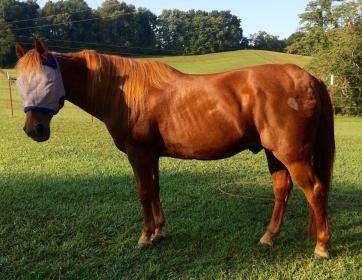This is pretty long, but here goes…
My mare was diagnosed with Laminitis on one front hoof about 3 months ago; she is 21, IR, Cushing’s, and has struggled with Navicular pain her whole life, though since I have owned her and got her in better farrier care the navicular issues were well controlled.
We took x-rays and they showed about 3 degrees of rotation and a little sinking. My farrier worked from those x-rays to modify her shoeing, she was on stall rest for a few weeks and on a two week course of Equioxx, we also put her on Thyro-L and resumed Cyproheptadine (she doesn’t tolerate Prascend). She has been on a low starch diet for years, and I switched to an even lower starch feed (the former feed was about 14% NSC and the new one is 8%). She lives in a 14 x 30 sand paddock; we added more sand and put shavings in as well under her shelter where she stands the most. She responded well and seemed to be improving so after she had been doing ok off of Equioxx for a month hand walking was added in slowly, and eventually walking under saddle. I was given some soft ride boots and they seemed to help her as well.
Then 2.5 weeks ago she had another laminitis flare up. We put her on twice daily oral banamine, increased the Thyro-L dosage, added in gabapentin, and pentoxifylline. Took new x-rays and the sinking seemed to be gone but the rotation had increased quite a bit and is now more like 10 degrees. Her sole depth was good and the vet said her shoeing looked ideal for her situation, my farrier redid her feet using the new x-rays and that seemed to help a little and there was slight improvement. After a week and the improvement we had seen, we tried to switch her from the Banamine to Equioxx. She did okay for about 48 hours and then got worse again, so we put her back on Banamine for another five days at a full dose for her weight, and then transitioned down to a half dose, still twice a day. She seemed to be holding steady or slightly improving for a few days again and we went off gabapentin as planned. Then she got worse again. We added the gabapentin back in, and she is continuing on the half dose of banamine twice a day as my vet is concerned about doing the higher dose longer and risk if kidney problems. My farrier will be out again today or tomorrow to see if she can get her any more comfortable. We have also been icing her once a day for at least 30 minutes using gel packs as my farrier doesn’t want her standing in water and I can’t get to the barn more than once a day. I have also been applying liniment or poultice (alternatingly) to her coronary band area. She is still pretty sore.
Here’s where I am hoping for input…
I am deeply concerned about her quality of life at this point. I am a firm believer that it is better to euthanize a day too soon than too late. But it’s still heartbreaking and I also don’t want to give up on her if this is something she can reasonably expect to recover from, even if just to soundness in the walk. I also do have to balance this with finances too, as much as I hate that money plays into it. I was unemployed for about 6 months, which I had savings to handle, but now even after being back in work for 4 months I only have a couple thousand available for this. My vet is aware and has said that she supports me either way with trying to continue treatment or euthanasia. She thinks there may be a chance of recovery perhaps since it is only in one hoof, but can’t say for sure either way. She has said I can consult with an equine podiatrist in the area or possibly do surgery to cut the tendon involved in the rotation process. So… thoughts? Advice? If this was your horse, what would you do? I know asking for advice from strangers is not a replacement for continuing to work with my vet and farrier, but I want to gain as many perspectives as I can to make sure I am not overreacting or missing something.


